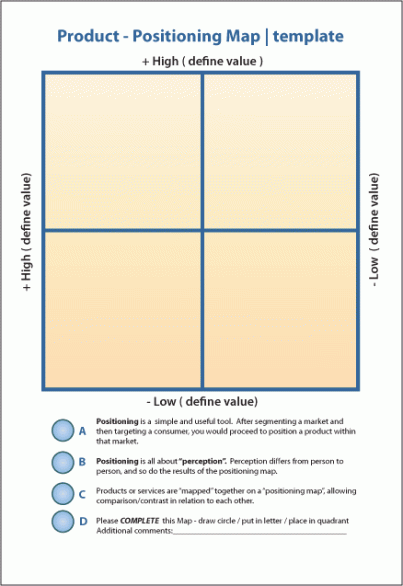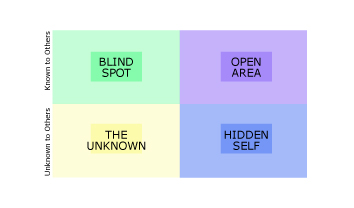Many visitors have downloaded this form and I am thrilled that others find it useful. Feedback from your target audience is a crucial element when planning and implementing a holistic marketing strategy for your company. I prefer to provide a visually compelling/customized form when gathering information for clients. This exercise is simple to conduct and will provide actionable insights. You can download the generic form below from www.marketingholistics.com. It’s also a snap for me to provide a custom designed positioning template (PDF format). You can specify two value variables and four product variables.

Visit the Marketing Holistics websiteto download the generic PDFor shoot me a fast e-mail and I’ll customize it for your use.
December 28, 2009
Posted by barbarareiner |
holistic marketing | holistic marketing, market segmentation, product positioning, strategic planning |
Leave a comment
LEARNING STYLES are fascinating and include: 
Accommodators – who learn by doing
Divergors – who learn by observing
Convergors – who learn by problem solving
Assimilators – who learn by getting information
CRITICAL CONSIDERATIONS include:
How do I learn?
How do others learn?
What can I learn today that is new and helpful?
How do I feel about the new knowledge I gain?
The challenge for marketers is to be able to identify the learning styles of a particular constituency/market. A successful internet marketer must be able to accommodate various learning styles. People frequently use the internet to research online and buy offline. A pet peeve when I ask a simple question is the person who does not glance up from a computer screen, waves a hand around in the air and seems truly disinterested. This happens to everyone.
Some marketing professions simply do not help their clients learn more about critical internet marketing functions. Some marketing professionals play their cards fairly close to the vest and prefer not share their knowledge or insights. A few years ago, when working with an SEO/SEM team, my manager instructed the technical staff not to answer my questions because I needed to figure things out for myself. He would then deliberately give me a vague assignment and refuse to clarify his intent. I am on the inside team and wondered how the client might feel. I called him on this and he did not appreciate it. Years ago, in a university marketing department another manger gave me an unclear assignment, would not clarify for me and acted impatient when I did not complete the work. She stamped her foot. I reported her to personnel. What I learned from this experience is that internal teams are very sensitive and sometimes dysfunctional. Our mutual boss was more concerned that I went “out of the department” for assistance than about the fact that I was not receiving effective direction. As a result of these and other similar experiences, I tend to go to the opposite extreme and prefer to explain “things” with abundant clarity.
Identifying and accommodating different learning styles is also important for the modern marketer who is, in essence, a facilitator and instructor. Marketers must identify and target segments. Similar challenges face instructors who must instinctively utilize a variety of pedagogical elements which are most relevant to a particular learning style. If I need to learn how to use a particular feature on my Blackberry I can ask a friend, who may pull the unit from my hand and perform the function and hand it back to me, I can go back to the Sprint store and take a number and wait in line or simply consult the manual.
Several years ago I worked in technology sales and the training was simply inadequate. The technical experts were permanently on voice mail and auto reply. A few days ago, I heard that this company just closed their Connecticut and New Jersey sales offices. My reply to former colleague’s email: “flawed business model.”
A few weeks ago, I was working with a team to design a presentation about the Economic Meltdown. I suggested providing a handout for a book about the history of the Federal Reserve System. I was thinking the study would be interesting and relevant for the audience and supportive of our position. Two members of the team really resisted: one from arrogance…he thought his opinions and input sufficient making independent documentation unnecessary; and another resisted from control….she wanted to edit my handout but would not read the book because she did not have time. Although this collaborative experience was far from optimal, the audience obviously appreciated the handout which was succinct and relevant. I am particularly sensitive to inadequate and rushed explanations.
Marketers must address multiple learning styles. Years ago when I first attended college, we would have a textbook and that was it. Books were not expensive, typically less than $25.00. Texts seem quite expensive today by comparison. I recently purchased a Business Law text for $185.00 – light winter reading for me between holidays. A hefty text price tag fortunately includes additional learning opportunities such as Power Points, online quizzes, and companion websites. As a side note: the price tag of the text prompted me to become a Barnes & Noble member to earn an extra discount. Wise decision since I have saved multiple times the price of membership!
Providing a variety of options which consider multiple learning styles facilitates communication. The principles of learning also apply to marketing. I have always found that it is very easy to ask a person how they prefer to gain knowledge. It saves everyone time and energy because you learn up front what works best for the person and how to vary an explanation. For example, when teaching a group of students about Adobe Photoshop, I ask the class: how many people prefer to learn by observing, by doing, by getting information, by figuring out themselves? I am always amazed at the variety of answers. A good instructor and marketer will frequently stop and ask questions like: “Are you with me?, Does that make sense?” Does it?
December 27, 2009
Posted by barbarareiner |
holistic marketing, internet marketing, marketing humor, photography | barnes and noble member, college textbooks, learning styles, vermont raptor |
Leave a comment
SELF AWARENESS means knowing about one’s idealized self in terms of aspirations as well as a sense of your presence at present. A component of self-awareness is knowing how one is perceived by others.  The Johari Model is a graphic model developed in the 1950’s which aids in the interpretation of self-awareness. This exercises involves psychological communication and the diagram is fairly self-explanatory.
The Johari Model is a graphic model developed in the 1950’s which aids in the interpretation of self-awareness. This exercises involves psychological communication and the diagram is fairly self-explanatory.
What’s involved:
- Apply a list of words to yourself.
- Have others apply the same list to you.
- Note the similarities
- Note the differences.
- Act on the insights
Do I have the courage to take a test in my blog? My personality is warm, upbeat, artistic, curious and engaging. I am interested in the arts particularly photography and design. I also like the politics of the Civil Rights Movement. I prefer to be generous but have tamed down that impulse over the years. I am happily married to a smart, kind, successful gentleman. We have two dogs and no children. I know “team dynamics” are a crucial business skill to develop. I am interested in marketing and working with small entrepreneurial businesses permits me the latitude to leverage my core communication skills.
I am also obsessed with learning new skills and improving existing ones. Right now I am reading four books:
- Web Analytics 2.o new by Avinash Kaushik [he was an author@Google – and donates the proceedes from his two book to charity]
- The Art of SEO by Enge Spencer, Fishkin and Stricchiola [fuzzy logic and semantic intent]
- Eyetracking Web Usability by Nielsen & Pernice [heat maps & gaze plots]
- Search Engine Optimization for Dummies by Clay & Esparza [anyone can do a redirect]
and have at least eight more piled on my night table.
The need to learn traces back to my childhood because my parents rewarded me for being a good student. Their praise and approval motivated me to constantly strive for “very good grades.” Now I learn for the pure sake of love of learning. Coworkers think that I have a high energy level and am focused and determined. Sometimes I am a tad impatient but always find time to help others. The good news is that it is never too late to improve and learn new things. My husband thinks that I am focused, motivated and smart but he also thinks that I sometimes allow myself to get a bit sidetracked by unimportant details and people with difficult personalities. He is 100% correct. I consider myself extremely responsive.
Shifting gears and seeing connections: Carl Jung identified four psychological archetypes: thinking, feeling, sensing and intuition. Understanding how other people relate has always helped me to create compelling visual communication. SWOT analysis, a classical marketing exercise involves determining an organizations internal strengths and weaknesses as well as external opportunities and threats. Holisitic Marketing also has four components: Relationship marketing, integrated marketing, internal marketing, & performance marketing. A Product Positioning Map also has four quadrants:At this point I am wondering why the above tests, models, models and maps all have four components and if there is something about the underlying structure of four components that becomes visually and literally compelling?
December 27, 2009
Posted by barbarareiner |
holistic marketing, internet marketing, search engine marketing | avinash kaushik, bruce clay, carl jung, holistic marketing, johari model, product positioning, swot analysis |
Leave a comment
 The Johari Model is a graphic model developed in the 1950’s which aids in the interpretation of self-awareness. This exercises involves psychological communication and the diagram is fairly self-explanatory.
The Johari Model is a graphic model developed in the 1950’s which aids in the interpretation of self-awareness. This exercises involves psychological communication and the diagram is fairly self-explanatory.

